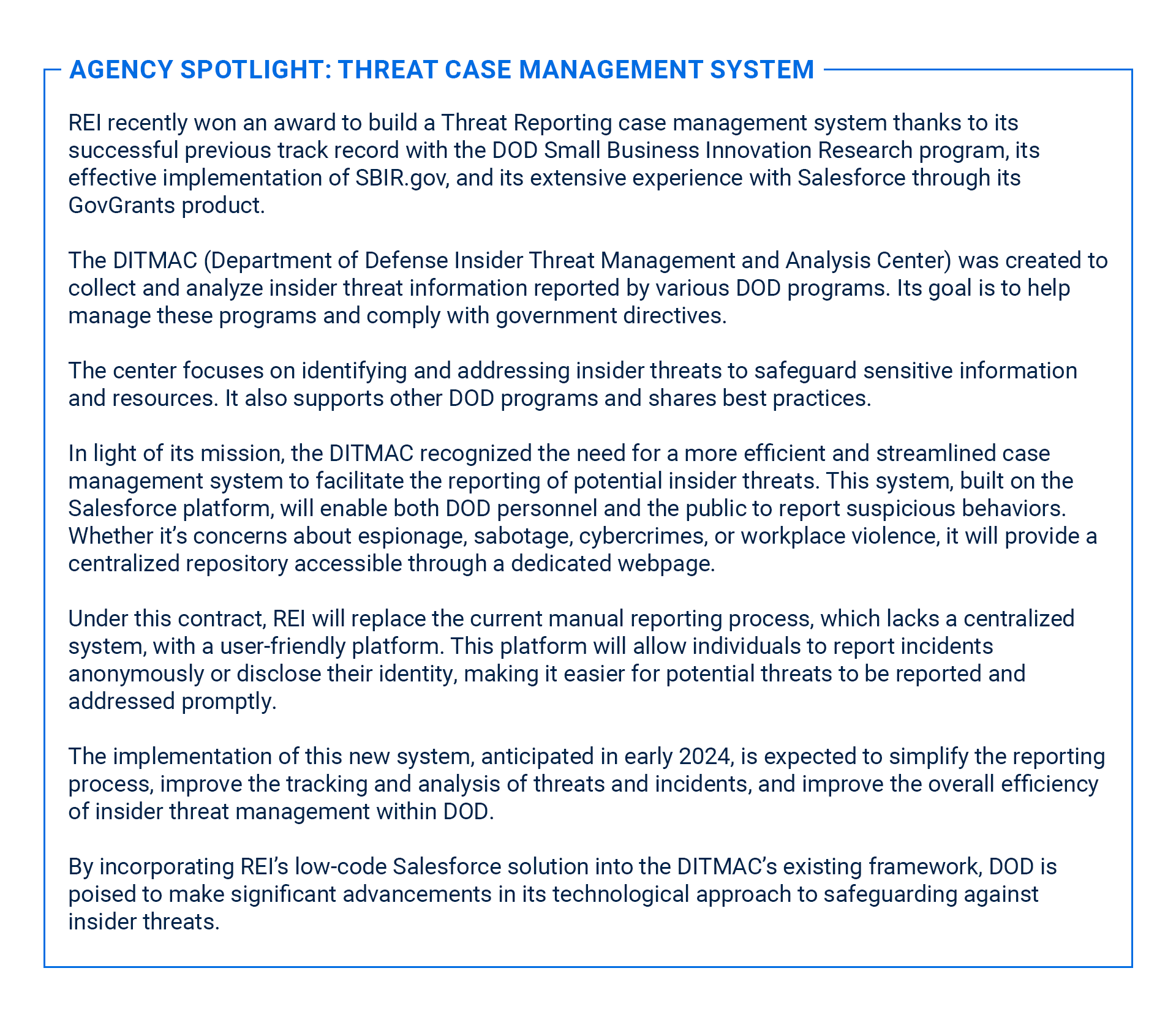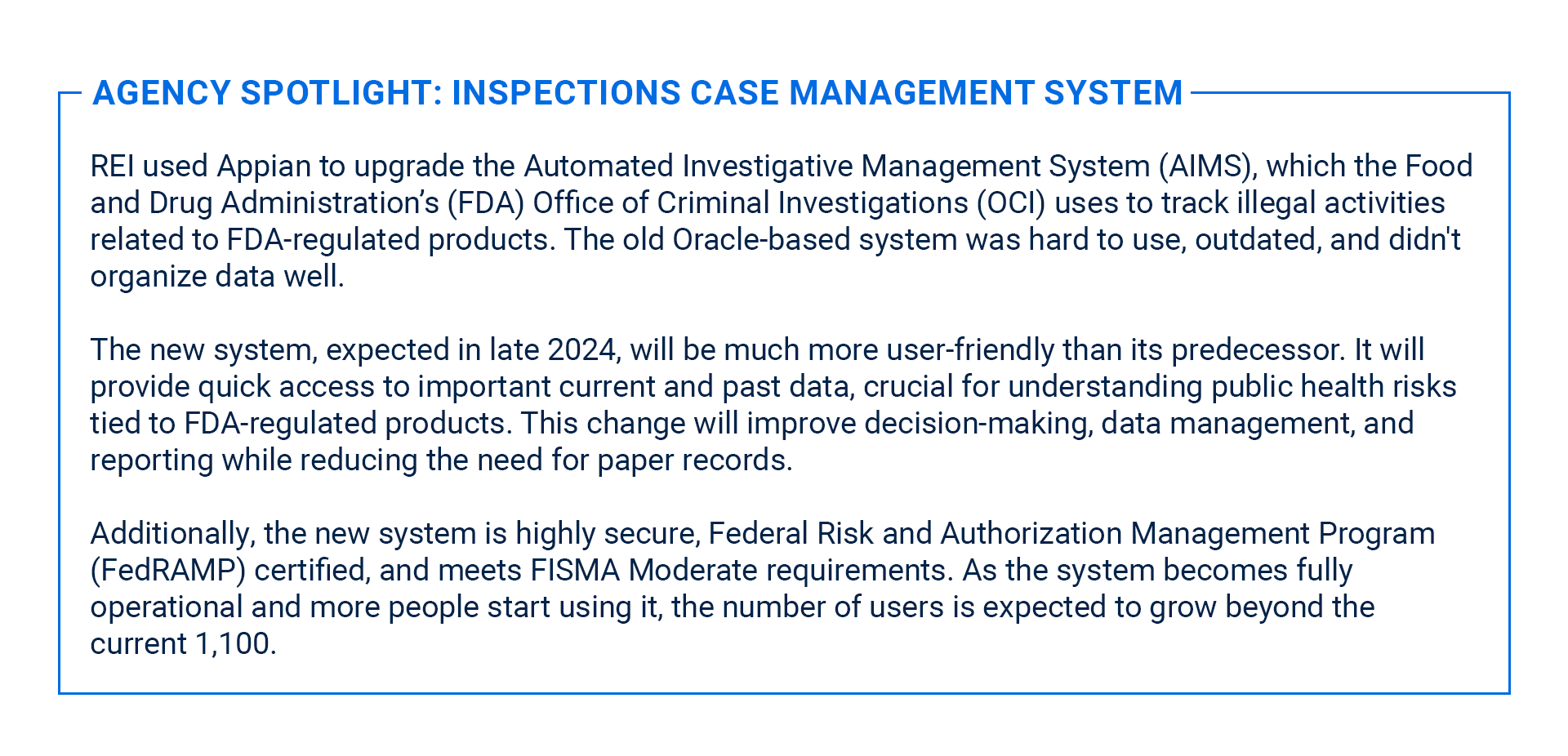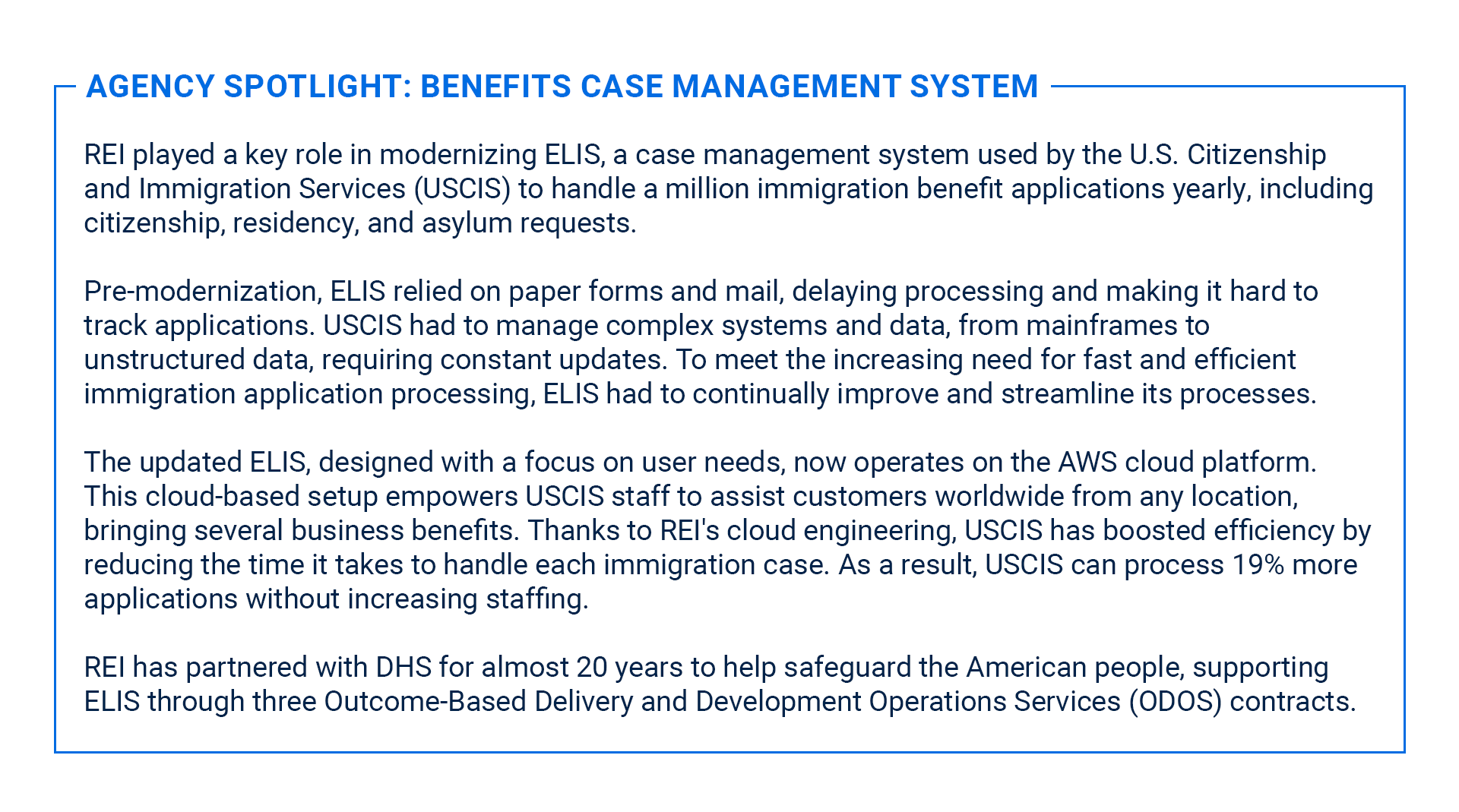Introduction: Modernizing Case Management in Government
Government case managers, for example, those who navigate through immigration, investigating fraudulent medications, helping trafficking victims, or overseeing judicial cases — all lean heavily on case management systems. These systems aren’t just organizing tools; they ensure seamless, rule-compliant, and transparent service delivery to the public.
Essentially, case management systems make data collection easy, helping agency experts make fast, informed decisions. The right system helps agencies manage various tasks, track decisions, stay consistent, quickly adapt to changes, enhance security, and easily collaborate with other systems and agencies.
However, older case management systems can slow down decisions and services and outdated security can lead to data breaches and threaten privacy. Furthermore, these systems may struggle to adapt to new laws and modern demands, affecting efficiency and compliance. A modern approach is vital for effective, compliant agency operations.
Revamping these systems is no longer optional — it’s a must for improving government services, speeding up response times, and continuously meeting public needs.
1. Understanding Case Management Systems
Gartner defines case management system as “applications designed to support a complex process that requires a combination of human tasks and electronic workflow, such as an incoming application, a submitted claim, a complaint, or a claim that is moving to litigation. These solutions support the workflow, management collaboration, storage of images and content, decisioning, and processing of electronic files or cases.”

Cloud technology revamped case management systems, slashing reliance on physical servers and opening up access through smartphones and tablets. Meanwhile, process automation and artificial intelligence (AI) adoption sharpened workflows and supercharged decisions with robust data insights.
As cybersecurity improved, integrating strong security protocols to protect sensitive data became essential. Systems also needed to easily sync with other internal and external systems to ensure seamless operations.
Today’s case management systems focus on user-friendly interfaces and encourage real-time collaboration. Data analytics provide insightful reports, identify patterns, and guide strategic decisions, meeting the varied needs of government staff and citizens.
In terms of case management, there are many different types, including:
Judicial Case Management: Navigating through the legal maze, this manages court cases by lining up court dates, keeping documents safe, and sticking to legal timelines.
Criminal Case Management: Focused on criminal law breaches, it meticulously tracks investigations, manages evidence, and ensures various law enforcement agencies work in tandem while preserving the rights of the accused.
Benefits Case Management: A helping hand for individuals accessing benefits, it assesses eligibility, processes claims, and delivers benefits on time. This includes keeping tabs on documents, interviewing individuals, and adjusting benefits as situations evolve.
Healthcare Case Management: Ensuring patients get the care they need, it plans, assesses, and advocates for health services, steering toward quality and cost-effective patient care throughout their healthcare journey.
2. Distinguishing Features of Case Management Systems
Case management systems navigate through the complex, dynamic workflows, often tailoring their route according to each unique case. They adapt, shifting the workflow based on current status or prior inputs. The USCIS ELIS, for instance, handles multiple tasks at once before moving to the next phase, adapting the workflow based on current status or previous inputs.
At their heart, case management systems are collaborative tools, facilitating communication among case stakeholders. The Administration for Children & Families’ (ACF) Shepherd Case Management System, for instance, lets users capture and record collaborative interactions and case-related comments. This helps team members communicate effectively, solve problems, and maintain information continuity.
Case management systems record every detail, including comments, decisions, emails, and workflow steps. This audit trail helps monitor changes and track a case’s journey. Detailed auditing is key in a case management system to ensure transparency and accountability at all stages of case handling.
Information tracking involves capturing and logging various elements, such as comments, collaborative events, email exchanges, decisions, and workflow steps, to understand the case’s progress thoroughly. The FDA’s AIMS system, is an example of this: It keeps a detailed audit trail that protects all actions and transactions in a case’s life. This ensures quick and effective handling of changes and potential issues.
When comparing simpler workflow systems like Shepherd to more dynamic ones like ELIS, several key differences become evident:
Scale and Complexity: Shepherd handles a straightforward case management solution, mainly focusing on working through the steps needed to certify human trafficking victims and providing services like counseling, healthcare, housing, and asylum. ELIS, on the other hand, deals with millions of immigration applications annually, compliance with legislation, diversity of immigration scenarios and situations, managing a complex dataset covering a wide range of immigration-related processes, including work authorization, visas, naturalization, asylum, and citizenship.
Implementation and Development: AIMS required a fit-gap analysis to identify what configuration and customization was required on the LCP. ELIS had detailed visioning and requirement gathering to document the modernization roadmap. Both used Agile methodology, DevSecOps and cloud-first deployment strategies.
3. Exploring Low-Code Solutions
Low-code development simplifies making applications by cutting down on manual coding. It uses graphical interfaces and pre-built components to help agencies quickly create and deploy software. This means even staff who aren’t developers can assemble application pages and workflows, and there’s less need for highly specialized IT skills.
For any agency, this means it can speed up application delivery, save on development, and adapt easily to change, streamlining its digital shift and quickly meeting evolving needs.
Low-code solutions offer agencies a flexible, budget-friendly way to update applications, providing a user-friendly alternative to monolithic legacy systems. These platforms easily integrate with modern technologies, sidestepping the communication and standardization issues of older systems, and ensuring smoother tech operations.
Today, Salesforce, Appian, and Pegasystems are common low-code platforms that provide robust out-of-the-box capabilities. Users can quickly build, configure, test, and launch applications using their visual tools and pre-made templates.
Low-code platforms offer many benefits, but it’s essential to evaluate your specific needs and goals before using them. Let’s explore the benefits and the drawbacks:
BENEFITS
Accelerated Development: Low-code platforms can speed up the updating of case management systems, quickly moving from legacy systems to new, digital, secure solutions with easy, drag-and-drop development. Contributed modules also allow for quicker development and easy adaptation to evolving business requirements.
Citizen Development: Low-code enables non-technical users, or “citizen developers,” to create or modify applications without the need for deep coding knowledge.
Budget Efficiency: Budget plays a key role in agency decisions. Low-code platforms typically offer a cost-effective solution for developing and maintaining applications.
Inclusivity in Development: Low-code platforms enable everyone, from experts and non-technical stakeholders, to actively participate in creating new case management systems, making them better suited to meet various user needs during digital transitions.
Facilitated Scalability: Low-code platforms are usually built to easily scale applications, which helps modern case management systems grow and adapt to changing needs.
Smooth Integrations: A low-code approach helps easily connect new case management systems with existing digital tools and outside services, making sure operations run smoothly across different government functions.
DRAWBACKS
Restrictions on Customization: While low-code platforms are easy to use, they might limit how much you can customize the case management system, which might impact meeting very specific needs or adding new features.
Complexity-Related Challenges: As case management systems grow and require complex features, low-code platforms might have limits in meeting these advanced needs.
Vendor Lock-in: Relying on an external vendor for a low-code platform carries risks, such as uncertainty in long-term support, stability, and updates, which are vital for keeping the case management system up to date. Additionally, some platforms may lead to more dependency on the vendor compared to others.
Keep in mind that with a low-code solution, an increasing number of users leads to higher costs.
4. Considering Custom Solutions
A custom case management system allows agencies to create software finely tuned to their specific needs and demands. Instead of adjusting to pre-built or standard software, agencies can design a system that aligns perfectly with their workflows, processes, and goals, offering advantages such as:
Handling Complexity and Customization: Custom systems are adept at managing high levels of complexity and can be extensively customized. This flexibility results in a more nuanced and adaptable solution, suited to the agency’s evolving needs and ensuring more effective and efficient case management.
Total Control for Tailored Solutions: With complete control over the code and architecture of the case management application, agencies can fine-tune the system to precisely match their unique needs. This is particularly beneficial for handling complex case management processes, as the system can be refined to address specific requirements.
Improved Efficiency: Custom systems can automate tasks, reduce manual work, and streamline processes, resulting in increased efficiency and productivity.
Avoids Vendor Lock-in: Custom case management systems free agencies from relying on external vendors. Agencies can update, modify, and expand their systems on their own terms, without being tied to vendor schedules, roadmaps or limitations.
Evaluating the time and cost of custom development means looking closely at timelines, resources, costs, ROI, alternatives, and long-term benefits.
Recognize that custom development typically takes longer than implementing off-the-shelf software. Determine if your agency can accommodate the extended timeline and whether the benefits of customization outweigh the additional wait time. Custom solutions also require thoughtful ongoing maintenance.
Understand that starting with custom software can be more expensive than buying existing software licenses. Make a budget that covers creating, testing, maintaining and enhancing the software, and ensure your agency can manage these expenses over time.
Lastly, make sure the custom system can adapt to future needs without significant extra costs. Identify possible risks, such as delays or becoming outdated, and plan for unexpected expenses.
5. Important Factors to Consider
Choosing between low-code and custom means analyzing your agency’s needs and goals so you have a system that’s future-ready, easy to scale, and efficient.
Important factors to weigh include understanding complex workflows, collaborative capabilities, mobile requirements, legacy system integration, and cloud migration strategies. Evaluate costs, maintain security standards, and scrutinize vendor reliance. If your agency has significant investments in specific technology or cloud services, transitioning to a new system like a low-code platform can be expensive and complex. Always consider your current technology and investments to avoid unnecessary complications or expenses.

Mobile features are crucial for many organizations, especially those needing quick field service deployment. Low-code platforms often include built-in mobile apps, making it faster and easier to launch mobile services.
Another important consideration is deciding between speed and customization. Low-code systems are fast to set up, great for urgent situations such as having to process millions of decisions with immigration benefits in the Afghan Refugee Crisis, and can adapt to policy changes quickly. However, they might not have very specific, tailor-made features. Your decision boils down to whether you want a quick start or a system that exactly fits your needs.
While a custom-developed system provides thorough customization for unique workflows and needs, it typically requires more time to implement. Agencies must consider their immediate objectives, ensuring the selected approach, whether favoring rapid deployment or detailed customization, is in line with both present needs and future ambitions.
Conclusion: Paving the Way to Modernization
Government agencies urgently need to modernize their case management systems. The big decision: Choose a fast, user-friendly solution such as the FDA’s AIMS system, or invest in a custom, but more tailored, system like the one USCIS uses.
Choosing the right technology solution or vendor is crucial for this journey. The solution should not only meet the agency’s current needs but also adapt to future demands and expansions. The vendor should guide the decision-making process, prioritizing the agency’s goals over specific technologies.
With 30 years of experience, REI helps agencies modernize case management systems using practices like Human-Centered Design and advanced technologies such as AI, providing innovative solutions to meet specific agency needs and ensure mission success.
Our approach is firmly rooted in flexibility and an in-depth understanding of our clients. We are technology-agnostic and committed to delivering the best fit for our clients. But above all, we are partners and trusted advisors, guiding agencies toward a technologically advanced future while ensuring a modernization journey that is inherently stable, secure, and evolves symbiotically with their evolving needs.
If you want to modernize your agency’s case management system, please get in touch with info@reisystems.com.
Authors:
Rujuta Waknis
Director Solution Engineering
Connect on LinkedIn
Chetan Rane
Associate Program Manager
Connect on LinkedIn











